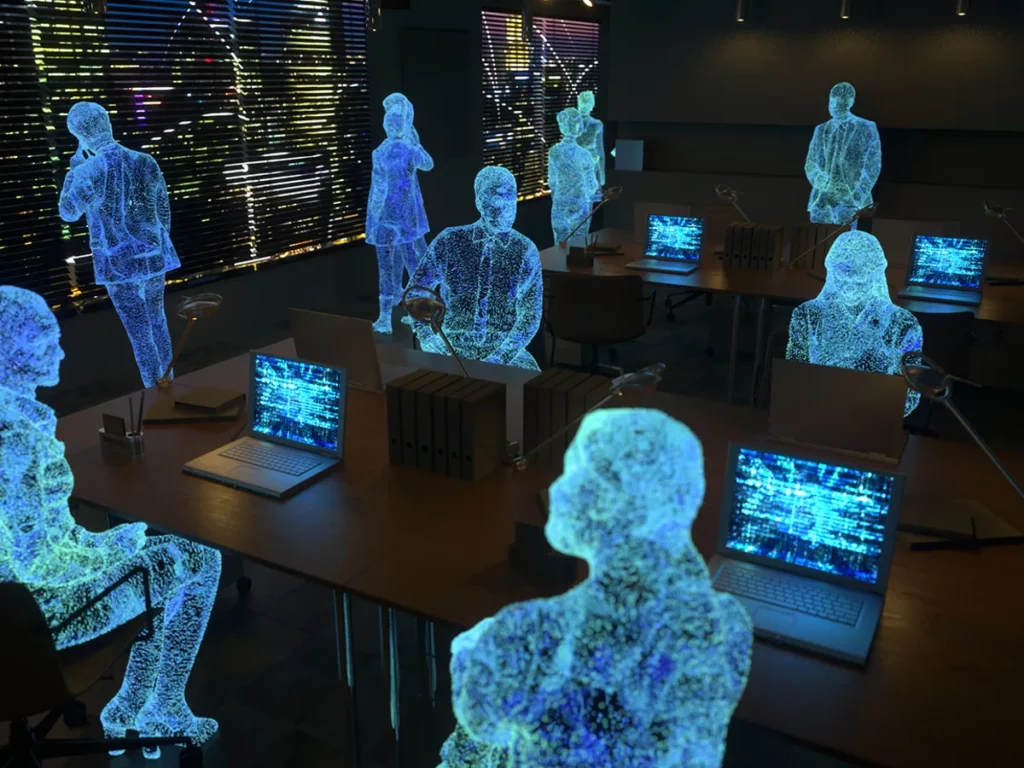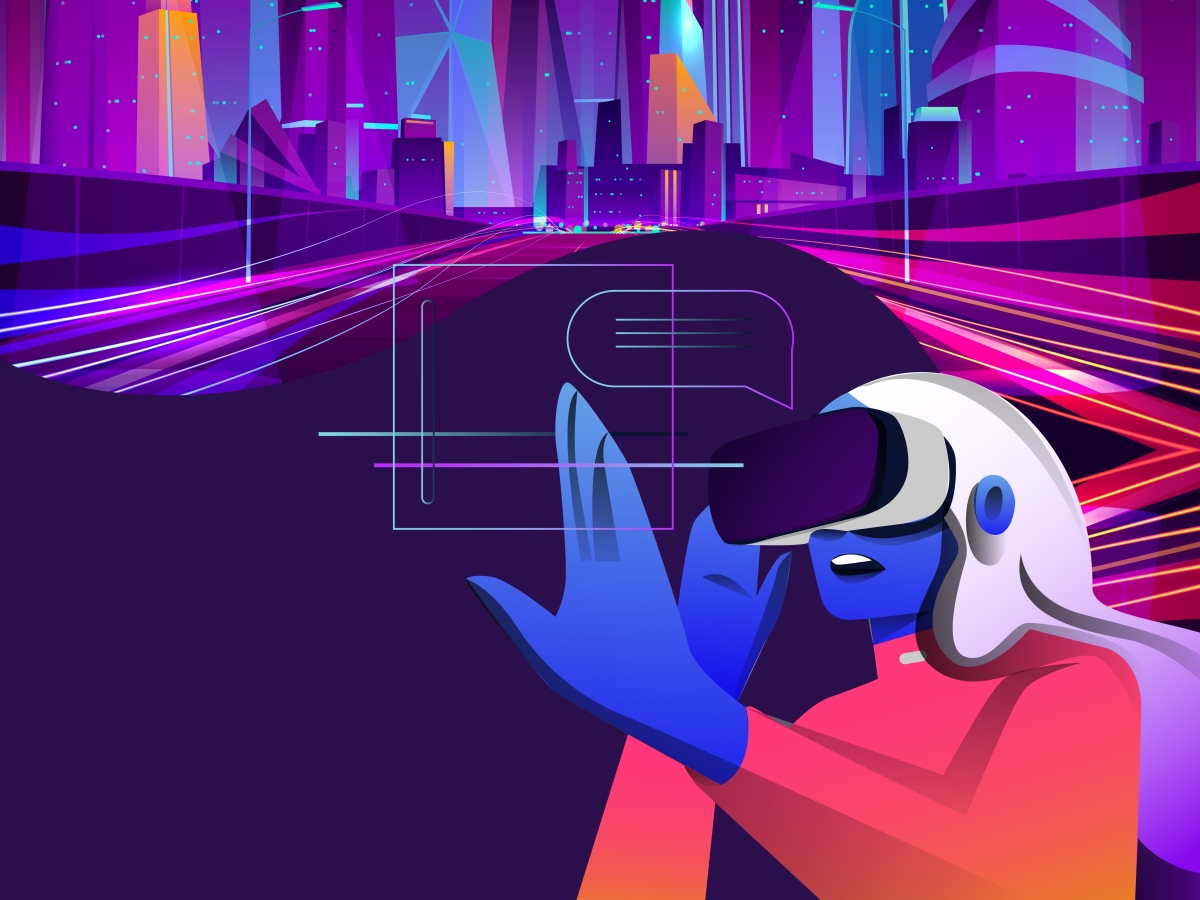The metaverse is a rapidly advancing digital space. It’s changing how we experience the online world. Just a decade ago, we were making phone calls and sending text messages. But with the metaverse, we’re entering a whole new dimension of digital possibilities.
The metaverse is gaining popularity, but many people still wonder how it all began. It is a fascinating concept. One can imagine it as the future of the internet. Various platforms will merge, much like websites in a web browser. What makes the metaverse special is that it lets you socialize. You can play games, meet people, and even work, all within 3D spaces.
In this article, we’ll explore the technologies that drive the metaverse and the story of how it came to be. We will delve into what the metaverse is, what it offers, and why it’s so important.
What Does it Mean?
The metaverse represents a kind of futuristic digital realm where the physical world meets virtual spaces. It creates a continuous and lasting environment for multiple users.
The metaverse is built upon the fusion of augmented reality (AR) and virtual reality (VR) technologies. These technologies enable diverse interactions with digital objects, virtual environments, and other people.
With the help of blockchain technology, concepts like cryptocurrencies and non-fungible tokens become feasible. This blockchain technology even allows individuals to own virtual assets. They can buy properties in places like Decentraland.
Companies like Meta and Microsoft are actively developing technologies. These will make interacting in virtual environments possible. Many other big players are working on the foundation needed to create more advanced and lifelike virtual worlds.
Talking about the metaverse today is similar to talking about the early days of the internet. Back then, people were excited about what this new way of connecting could bring to our lives. Likewise, the metaverse is sparking curiosity. People are investing significant amounts of money in it. In 2021, companies linked to the Metaverse raised over $10 billion. In 2022, the investments in the metaverse will have already exceeded $120 billion. Some experts even predict it could be valued at up to $5 trillion by 2030.
So, what exactly is it? It’s a unique digital space where people can interact with each other. It combines various technologies and can serve as a place for work, owning digital assets, having fun, using social media, and much more. However, it will take some time for it to evolve and fully become a part of our daily lives.
Brief History
The word “metaverse” comes from two Greek words: ‘meta,’ which means beyond, and ‘verse,’ which means universe. So think of it as a universe that goes beyond reality and has the potential to replace many parts of our lives.
The term itself originally appeared in Neal Stephenson’s science-fiction novel Snow Crash, way back in 1992. It started as a fictional concept. But now it’s becoming something that might actually happen. This book painted a picture of a future where millions of people would hang out in a digital world using virtual avatars. The concept got even more attention when Ernest Cline released his novel Ready Player One in 2011. In this story, ordinary people would slip on VR headsets to jump into a virtual universe and live out their dreams.
Around the early 1990s, a company called Sega came up with VR gaming gadgets like the Sega VR-1 motion simulator. These were designed to give arcade gamers some thrilling experiences. These early gadgets are like the great-grandparents of today’s metaverse. But it wasn’t until the early 2020s that Facebook decided to change its name to Meta. This is when the word “metaverse” started to become familiar to everyone.

The 7 Layers of the Metaverse
Jon Radoff, an entrepreneur and author, has proposed that the metaverse consists of seven distinct layers. Each layer plays a key role in shaping the user’s experience:
- Experiences: In the metaverse, physical limitations disappear as real-world spaces transform into digital realms. It has introduced new, diverse experiences.
- Discovery: Users find new platforms and technologies through app stores, search engines, and review sites. This layer is vital for exploring and connecting with various communities.
- Creator Economy: Developers use different tools to create digital assets and experiences. User-friendly tools like drag-and-drop options are becoming more common.
- Spatial Computing: By blending mixed reality (MR), virtual reality (VR), and augmented reality (AR), spatial computing allows users to interact in 3D environments. It enhances the overall experience.
- Decentralization: The metaverse has no single controlling authority. Blockchain technology supports scalable ecosystems. It enables businesses to offer specialized digital assets as the metaverse expands.
- Human Interface: The hardware aspect ensures that users are represented as realistic 3D avatars in virtual worlds, increasing immersion.
- Infrastructure: This layer includes the technology powering our devices. It connects us to networks and delivers content. Over time, 5G networks will significantly enhance the Metaverse’s capacity.
Metaverse Features
This emerging technology has some key features. These define and make up its components.
AI Integration
Artificial intelligence (AI) plays an important role in the metaverse. It powers content analysis, speech processing, computer vision, and more. AI is vital for business applications, including AI-driven chatbots for sales, marketing, and customer support.
DAOs for Governance
Decentralized autonomous organizations (DAOs) use blockchain and smart contracts for consensus in decision-making. This ensures that all members can participate in governing Metaverse resources.
Human-Computer Interface (HCI)
HCI facilitates interaction between humans and computers. It allows users to engage in various activities. It is essential for enabling people to connect with computing systems effectively.
Focus on Social Metaverse Interactions
In the metaverse, users communicate and interact through avatars and visual representations in cyberspace. These interactions bridge the economic and physical limitations of real-world locations. It creates a limitless virtual environment.
Support for Web3
Web3 represents a new era of the internet. It emphasizes user ownership and control over online content and assets. So, it aligns with these technologies. It provides a foundation for connectivity in this digital realm.
Avatars
The Metaverse lets you create unique digital avatars to express yourself. These avatars can resemble you or even your favorite pop culture icons. You can customize and gamify them for an interactive experience.
Decentralization
The metaverse develops through decentralization. This means it’s a shared reality without a central authority. Users can own virtual assets and experiences without relying on a governing body.
Remote Work Enhancement
Remote work could undergo a revolution because of the metaverse. Managers can read employees’ nonverbal cues through avatars, track productivity, and address workplace issues effectively.
Security
Ensuring ethics and privacy within the metaverse is important. Like today’s internet, it needs secure transactions and ethical behavior to safeguard users.
Diverse Hardware
Accessing the metaverse isn’t limited to virtual reality headsets. You can enter using various devices, including laptops, PCs, smartphones, and tablets. The supporting infrastructure is vital to keeping everyone connected in this digital realm.
Metaverse Technology
The world of the metaverse requires certain gadgets and technology. These tools are essential for experiencing this new digital universe, especially because the metaverse is primarily a visual experience.
Basic Hardware
You can start your metaverse journey using a smartphone. But to take things to the next level, upgrading your hardware is a good idea. Newer smartphones or tablets work great for entry-level augmented reality (AR) apps. However, if you want a more smooth experience, consider getting a modern device. It is more needed if your current one is over two years old.
When it comes to more advanced two-dimensional experiences, a powerful laptop or desktop computer is important. Look for a machine with a capable graphics card (minimum 4GB), a fast processor (at least 3.5GHz for the CPU), and a fast internet connection. This setup ensures you can access metaverse platforms without any lag.
For the most engaging experience, virtual reality (VR) headsets are the way to go. They allow you to fully indulge yourself in the metaverse’s platforms. Ensure your VR headset offers high-resolution graphics to enjoy the best quality.
To enhance your experience, consider using noise-canceling headphones with a built-in microphone. These can provide an additional layer of realism. They engage without the need for a VR headset.
Metaverse Software
Several cutting-edge technologies make the metaverse a reality. Here are the key ones:
Blockchain technology provides transparent and decentralized digital proof of ownership, value exchange, and digital collectibles. Cryptocurrencies enable transactions and interactions within the 3D digital environment.
AR and VR technologies offer 3D experiences that combine the real world with the virtual one. AR adds digital elements to the real environment through devices like smartphones. VR creates virtual worlds you can explore with headsets, sensors, and gloves.
Edge computing reduces data transport delays. The availability of 5G networks plays a vital role in ensuring an uninterrupted metaverse experience. These technologies eliminate lags and ensure smooth interactions.
3D reconstruction technology, initially used in real estate, allows for the creation of realistic and natural-looking digital environments. It’s used to replicate real-world objects, buildings, and locations in the metaverse.
IoT connects real-world devices to the metaverse and enables data collection and distribution. This connection enhances the precision of digital representations. It allows real-world devices to influence the metaverse’s behavior, creating dynamic simulations.

These technologies come together to create the interactive metaverse we know today.
Metaverse Platforms
The buzz around the Metaverse has spurred a quest for its platforms in 2023. Tech giants like Facebook, NVidia, and Microsoft are developing their own solutions. What lies ahead in the world of the metaverse? The answer can be found in the following list of highly coveted Metaverse platforms:
Decentraland
Valued at approximately $5.6 billion, Decentraland is where the metaverse comes to life. It’s a social virtual universe that serves as a home for the metaverse. Despite a minor dip in December, the MANA cryptocurrency has seen its value grow more than fourfold in just three months. Decentraland stands as the inaugural online decentralized environment and boasts the largest Metaverse cryptocurrency. Decentraland’s Metaverse operates under the DAO (decentralized self-governing organization). It features important smart contracts, notably the LAND contract. This allows users to trade digital real estate within the network.
Roblox
No list of Metaverse platforms would be complete without mentioning Roblox. It was originally established as an online gaming platform. It allowed users to design their own games. Roblox has now evolved into a comprehensive Metaverse platform. It offers a diverse array of virtual experiences, including immersive VR interactions. Roblox recently announced a partnership with the NFL to create a Metaverse game ahead of the 2022 Super Bowl. What sets Roblox apart is its commitment to uniting a wide range of experiences under one roof.
Bloktopia
Bloktopia’s innovative approach to the metaverse revolves around a towering skyscraper theme. This concept is designed to provide users with a platform for learning, socializing, and conducting business. They can explore various professions within a 21-story structure. Due to its open-ended design, Bloktopia will heavily rely on user engagement and creativity. While many details about this upcoming project remain under wraps, there are intriguing hints, such as a section dedicated to WWE. Notably, levels 1 to 6 will be accessible right from the start, with the contents holding an enticing sense of mystery.
As it continues to evolve, the metaverse opens new possibilities, and its development will be closely watched in the years to come. Talk to our experts to understand how modern Metaverse technology can help boost your business. Get a free consultation today!

















